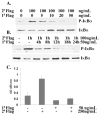Modulation of corneal epithelial innate immune response to pseudomonas infection by flagellin pretreatment
- PMID: 17898290
- PMCID: PMC2666382
- DOI: 10.1167/iovs.07-0473
Modulation of corneal epithelial innate immune response to pseudomonas infection by flagellin pretreatment
Abstract
Purpose: A prior study showed that Toll-like receptor (TLR)-5 recognizes Pseudomonas aeruginosa flagellin and triggers the production of proinflammatory cytokines in human corneal epithelial cells (HCECs). The present study was conducted to determine how the inflammatory response is modulated after TLR activation in HCECs.
Methods: HUCL cells, a telomerase-immortalized HCEC line, and primary cultures of HCECs were pretreated with low-dose flagellin and then challenged, with either a high dose of flagellin or with Pseudomonas. NF-kappaB activation was determined by the extent of IkappaB-alpha phosphorylation and degradation and of nuclear p65 DNA binding. The amount of cytokines in the culture media was assessed by ELISA. The activation of p38 and JNK and the cellular expression of TLR5 were determined by Western blot analysis. Cell surface distribution of TLR5 was assessed by flow cytometry. The expression and secretion of antimicrobial peptides were assessed by semiquantitative RT-PCR and slot-blot analysis, respectively.
Results: Pre-exposure (12-24 hours) of HCECs to low-dose flagellin induced a state of tolerance, characterized by impaired activation of the NF-kappaB, p38, and JNK pathways and reduced production of IL-8 and TNF-alpha on subsequent challenge with a high dose of flagellin. Flagellin-induced tolerance did not alter the cellular level and surface distribution of TLR5. Furthermore, flagellin priming of HCECs dampened the inflammatory response of HCECs to live Pseudomonas. Pseudomonas-induced upregulation of antimicrobial genes such as hBD2 and LL-37 was augmented, even in tolerized HCECs.
Conclusions: Pre-exposure of the ocular surface to TLR agonists may induce protective mechanisms that not only modulate the host inflammatory response but also provide an innate defense against bacterial infection in the cornea.
Figures






References
-
- Kurpakus-Wheater M, Kernacki KA, Hazlett LD. Maintaining corneal integrity how the “window” stays clear. Prog Histochem Cytochem. 2001;36:185–259. - PubMed
-
- Medzhitov R, Preston-Hurlburt P, Janeway CA., Jr A human homologue of the Drosophila Toll protein signals activation of adaptive immunity (see comments) Nature. 1997;388:394–397. - PubMed
-
- Medzhitov R. Toll-like receptors and innate immunity. Nat Rev Immunol. 2001;1:135–145. - PubMed
Publication types
MeSH terms
Substances
Grants and funding
LinkOut - more resources
Full Text Sources
Research Materials

